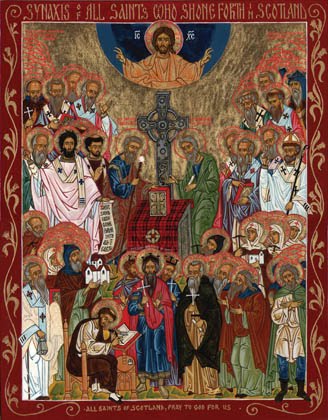His Eminence Archbishop Gregorios of Thyateira and the
Chairmanship of His Excellency Metropolitan Kallistos of Diokleia.
_____________________________________________________________________
GLORY TO GOD!
There will be a temporary IONA ORTHODOX CENTRE at CLACHANACH
for a fortnight in both
Spring and Autumn 2012
The dates are:
Saturday 28th April - Saturday 5th May
Saturday 5th May - Saturday 12th May
andSaturday 5th May - Saturday 12th May
Saturday 15th September - Saturday 22nd September
Saturday 22nd September - Saturday 29th September
Saturday 22nd September - Saturday 29th September
You are invited to make your individual Pilgrimage/Retreat during any of these weeks.
It is expected that there will be an Orthodox Priest resident for much of this time.
5 minutes from the Abbey and from St. Oran's Chapel.
The 12th Century ST. ORAN'S CHAPEL; oldest building on Iona.
THE ISLE OF IONA - a beautiful and sacred place
Colum Cille - St. Columba - came to Iona from his native Ireland about 563 A.D.
From Iona, Columba and his monks spread Celtic Christianity through North Britain.
They were in communion with all Orthodox Christians.
If you would like to become part of a temporary Orthodox Community on Iona
for a week;
to make a private retreat or an individual pilgrimage,
or simply to enjoy the peace and tranquillity of Iona
... where the veil between Heaven and Earth grows very thin ...
then please contact as soon as possible:
| |
- if interested in April-May Retreats -
Reader Ignatios Bacon, Oratory of the Theotokos and St. Cumein, Kilchuimen/Fort Augustus, Scotland PH32 4DG Telephone: 01320 366457 |
| | If your interest is in a September Retreat - Fr. Mark McBeth, 35 Buchanan Drive, Burnside, Glasgow G73 3PF Tel. 0141 647 2728 and 0787 2536 105 | The September retreats will be led by Fr. David Gill |
THREE RECENT EXPERIENCES OF IONA
Long journey, rough sea crossing, arrival exhausted on a beautiful atmospheric island. The welcoming house with good food and regular morning and evening worship in the local old chapel.
The beauty of the island when the sun shone was breathtaking, and even mystical in the rain.
A wonderful visit for reflection, renewal, rest and company. I long to go again.
Margaret Handley
Mar 16 2012
I had waited many years to fulfil my ambition of going to Iona but when Iona Orthodox retreats offered me the opportunity of doing so, it did not disappoint. There is a painting by John Duncan, 'Saint Columba Bidding Farewell to the White Horse', where the horse, sensing the Saint's impending death, comes to see him for the last time. For me, this captures precisely the spirit of Iona: the oneness of spirituality and nature.
At Matins and Vespers in Saint Oran's Chapel, the prayers are accompanied by House Martins darting in and out of the chapel door to their nest in the rafters.
Having walked to Saint Columba's Bay, the tranquillity was broken by a sense that I was being watched. Looking out to sea I found I was being observed by a sealwhich had surfaced just offshore. It dived and surfaced to stare at me , dived and surfaced before it returned to the sea and I turned to retrace my steps.
I found Iona to be a place with a unique form of peacefulness which invites and encourages contemplation and prayer. I returned to the mainland, with its bustle and distractions, with a host of memories but also physically revitalised and spiritually refreshed.
Martin Stone
I spent a few days on Iona last Autumn. I found it to be a very peaceful place. It was really getting one to one with nature with the grass and the sheep and the cows, which were all really laid back. On the way over, I had never seen so many rainbows in my life. I met some lovely people in the Orthodox retreat house and St. Orans Chapel was a good setting for the prayer services.
Charlotte Anna
